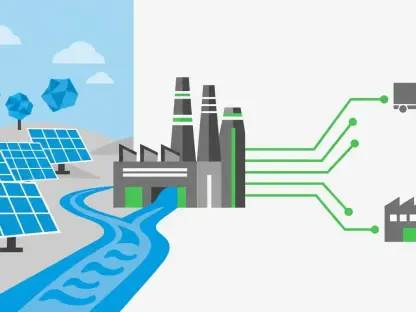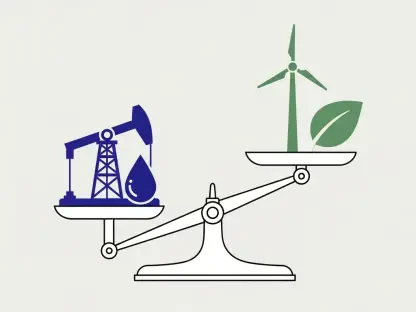Railway transportation is undergoing a significant transformation with the integration of advanced silicon carbide (SiC) modules. Leading the charge, Infineon’s XHP 2 CoolSiC MOSFET technology shapes the future of more energy-efficient, compact, and durable rail systems. This article explores how these cutting-edge modules are driving the shift towards decarbonized railway transportation and the multifaceted benefits they offer.
Revolutionizing Energy Efficiency in Rail Transport
Lower Power Losses with SiC Technology
Silicon carbide semiconductors stand out for their impressive ability to reduce power losses. Traditional silicon semiconductors often lag in efficiency, causing higher energy consumption and operational costs. By contrast, SiC technology slashes power losses, ensuring that traction converters—key components in electric and hybrid trains—operate more efficiently. With better energy management, railway operators can significantly cut down their overall energy expenditure, leading to more sustainable operations.
In contrast to their silicon counterparts, SiC modules offer exceptional performance in high-temperature and high-voltage environments. Traditional silicon-based systems struggle to operate efficiently under such conditions, leading to increased energy wastage and reduced reliability. By replacing silicon with SiC, railway systems can function more reliably and sustainably, crucial for the constant demands of modern rail transport. Consequently, SiC technology does not merely offer incremental improvements; it represents a foundational shift toward more sustainable and efficient rail operations.
Field Test Insights and Broad Implications
A notable field test by Siemens Mobility and SWM showcased a 10% boost in energy efficiency when employing Infineon’s XHP 2 CoolSiC modules. This considerable efficiency gain demonstrates the pragmatic benefits of adopting SiC technology. Such advancements are critical in pushing the industry toward greener practices, helping railway systems lower their carbon footprints and advance closer to net-zero emissions goals.
The practical implications of these tests are substantial. For instance, reducing energy consumption by just 10% across a large-scale transportation network can result in significant cost savings and reduced greenhouse gas emissions. Beyond financial and environmental benefits, these advances carry strategic importance. By optimizing energy usage, railway operators can allocate saved resources to other critical areas like infrastructure improvements and technological advancements, making the entire ecosystem more robust and future-ready. In essence, the broad implications of deploying SiC modules extend beyond mere energy savings—they catalyze a holistic transformation in railway management and operations.
The Pursuit of Compactness and Weight Optimization
Enabling Compact Traction Converters
SiC modules significantly contribute to the development of more compact and lighter traction converters. This compactness is paramount in hybrid-propulsion trains, which require efficient space management to incorporate various propulsion and energy storage systems. By leveraging the high power density of SiC modules, engineers can design traction converters that are not only smaller but also deliver higher performance.
Space optimization plays a crucial role in modern rail systems, especially where physical constraints are a constant challenge. Advanced SiC modules allow for more streamlined integration within existing rail frameworks, facilitating retrofitting processes and enhancing overall system compatibility. The space saved by using smaller, more efficient traction converters can be used to incorporate additional or backup systems, thereby increasing the resilience and versatility of railway operations. By achieving this balance of compactness and performance, SiC technology contributes to both operational flexibility and enhanced user experience in hybrid and electric rail units.
High Power Density and System Integration
Infineon’s 3.3 kV SiC XHP 2 modules exemplify how higher power densities can be achieved. These modules can provide up to 50% more output current at the same switching frequency or maintain output at higher frequencies. This increased power density allows for the reduction of large magnetic components, which further aids in minimizing the overall weight and size of the converters. As a result, rail vehicles can maintain their performance without compromising on space or weight constraints.
This capability to maintain higher output while reducing component sizes translates into tangible benefits for railway operators. Lighter, more efficient components mean reduced wear and tear on the train’s mechanical systems, contributing to lower maintenance costs and prolonged service life. Additionally, by reducing the operational weight, trains consume less energy, thereby enhancing fuel efficiency and further decreasing operational costs over the long term. The integration of SiC technologies thus presents a multifaceted advantage, paving the way for more streamlined, cost-effective, and efficient railway systems that align seamlessly with the growing demands for sustainability and performance.
Enhancing Durability and Longevity of Rail Systems
Advanced Interconnection Technologies
Durability and reliability are key concerns in railway transportation. Infineon’s .XT technology plays a crucial role by enhancing the power cycling capabilities of SiC power modules. This advanced interconnection approach mitigates the thermomechanical stresses that power modules often endure, making them more resilient against the rigorous cycling demands of rail applications.
The durability offered by .XT technology ensures that railway systems can withstand the harsh conditions often encountered in daily operations, including temperature fluctuations and constant mechanical vibrations. This robustness is particularly beneficial in reducing the frequency of system failures and the need for unscheduled maintenance, thereby increasing the overall reliability of the rail network. Moreover, with enhanced power cycling capabilities, SiC modules can better manage the dynamic electrical loads typical of modern railway systems, ensuring consistent and unfaltering performance under varying operational conditions.
Tenfold Increase in Service Life
Simulation studies comparing standard joining technologies with Infineon’s .XT bonding reveal a tenfold increase in product longevity. By significantly reducing wear and tear, these innovations ensure that SiC modules can maintain high performance over extended periods. This durability means fewer maintenance requirements and longer intervals between replacements, which translates to reduced downtimes and lower operational costs for railway operators.
The economic benefits of increased product longevity extend beyond direct maintenance costs. Longer-lasting components reduce the need for inventory stockpiling of spare parts, lowering warehousing costs and simplifying logistics. Additionally, fewer maintenance disruptions enhance operational efficiency and ensure that trains remain in service for longer periods, maximizing revenue generation and ensuring punctuality. By extending the service life of critical components, Infineon’s .XT technology contributes not only to the economic sustainability of railway operations but also to strategic planning and resource allocation, fortifying the entire transportation infrastructure against future challenges.
Economic and Environmental Benefits
Cost Efficiency and Energy Savings
Implementing SiC modules introduces economic efficiencies by reducing energy consumption and related costs. With these modules enhancing energy efficiency, rail operators can see a marked decrease in energy bills. Additionally, the reduced size and weight of traction converters lead to a lower cost of production and maintenance, further enhancing the economic viability of rail systems equipped with SiC technology.
The cost-effectiveness of SiC modules becomes increasingly significant in the context of global economic pressures and the growing emphasis on sustainability. By minimizing operational expenditures related to energy consumption, railway operators can achieve more predictable and manageable budgeting, stabilizing their financial models. This financial stability, in turn, supports further investment in advanced technologies, creating a positive feedback loop that promotes continual improvement and innovation. Thus, the deployment of SiC modules not only addresses immediate economic concerns but also positions railway operators for long-term growth and competitiveness.
Reducing Battery Costs
One of the primary cost drivers in hybrid-propulsion trains is the battery system. SiC modules play a crucial role in this regard by improving the overall energy efficiency of the system, which allows for smaller and less expensive batteries. This cost reduction provides a significant economic edge, making the adoption of hybrid and fully electric propulsion systems more financially feasible for railway operators.
By reducing the size and cost of batteries, SiC modules enable operators to allocate resources more effectively, prioritizing other critical areas such as infrastructure upgrades and passenger amenities. This makes green technologies more accessible, accelerating the broader adoption of hybrid and electric rail systems. Environmental benefits follow suit, as smaller and more efficient batteries reduce the ecological footprint of battery production and disposal. In this way, SiC technology not only delivers direct financial savings but also supports broader environmental and strategic objectives, fostering a more integrated and sustainable approach to rail transportation.
Noise Reduction and Thermal Management
Quieter Train Operations
Traditional traction converters often rely on forced air-cooling systems, which can produce considerable noise. SiC modules, however, enable higher switching frequencies that simplify the cooling requirements, resulting in quieter operation. This not only improves passenger comfort but also reduces noise pollution, contributing to a more pleasant and eco-friendly urban environment.
Noise reduction is a critical factor in enhancing the overall passenger experience, particularly in urban areas where trains frequently operate near residential neighborhoods. By reducing auditory impact, rail systems become more compatible with densely populated regions, fostering better community relations and compliance with stringent noise regulations. Improved passenger comfort, in turn, contributes to higher satisfaction and potentially increased ridership, which further justifies the investment in advanced SiC technologies. The quieter operation of SiC-enabled trains thus serves both social and economic imperatives, aligning rail systems more closely with the demands of modern urban living.
Simplified Cooling Systems
The efficient thermal management offered by SiC modules allows for more streamlined cooling systems. By minimizing excess heat and managing thermal dissipation more effectively, trains can operate at optimal temperatures without the intricate and noisy cooling mechanisms traditionally required. This leads to further energy savings and prolongs the life of cooling components, adding to the overall reliability and efficiency of the rail transport system.
Simplified cooling systems also contribute to reduced energy consumption, as less power is required to maintain optimal operating temperatures. This enhances the overall energy efficiency of railway systems, aligning them more closely with environmental sustainability goals. Moreover, the reduced complexity of cooling systems translates into lower maintenance requirements and fewer points of failure, ensuring consistent and reliable operation. By integrating efficient thermal management, SiC technology addresses multiple operational challenges simultaneously, paving the way for smarter, more sustainable rail transport solutions.
Conclusion
Railway transportation is experiencing a major evolution with the introduction of advanced silicon carbide (SiC) modules. Leading this transformation is Infineon’s XHP 2 CoolSiC MOSFET technology, which is setting the stage for rail systems that are more energy-efficient, compact, and durable. By incorporating these cutting-edge SiC modules, the railway industry is taking significant strides toward decarbonization, achieving a cleaner and more sustainable form of transportation.
Infineon’s XHP 2 CoolSiC MOSFET technology offers numerous advantages, including enhanced energy efficiency, which helps in reducing the overall carbon footprint of railway systems. This technology also contributes to increased durability and smaller equipment size, making it easier to integrate into existing rail infrastructure. The benefits extend beyond just environmental impacts; they also promise improved performance, reliability, and lower maintenance costs for railway operators.
Moreover, the compact nature of SiC technology allows for better utilization of space within rail vehicles, providing more room for passenger and cargo areas. This efficiency means that trains can be more productive and provide better services without the need for significant redesigns.
In summary, the integration of Infineon’s advanced SiC modules is revolutionizing the railway industry, paving the way for greener and more efficient transportation solutions. As this technology continues to advance, it will play a crucial role in shaping the future of sustainable and resilient rail systems.









